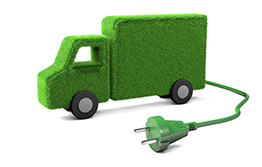
As renewable energy becomes more cost-effective and commonplace, agencies may choose to begin replacing their winter maintenance vehicles and equipment with a fleet that has a smaller carbon footprint. A new Clear Roads synthesis report includes best practices from earlier fuel transitions, recommendations, and future considerations for making winter maintenance fleets greener.
While electrification and alternative fuels may be on the horizon for winter maintenance fleets, the transition will be no small task. Winter maintenance managers need to ensure these vehicles can provide the power and durability needed to operate in harsh winter conditions.
The project documented available technologies, energy sources, practical considerations, and other needs that state DOTs may have in migrating their winter maintenance fleets to electric or alternative fuel vehicles.
Overall, the research team discovered that the use of alternative fuels in winter road maintenance operations was quite limited and the use of electrification virtually non-existent. DOT managers hold “healthy skepticism about their future uses due to the rigorous requirements of the vehicles and equipment,” the authors write.
Winter maintenance managers in the study had questions about safety, costs, life cycles of batteries, and the impact of salt and other deicers on electric vehicle components. Other needs included:
- Infrastructure for maintenance and refueling, including over large geographic areas around a state.
- Specialized training for mechanics and other maintenance staff.
- Funding to support a multiyear replacement schedule and separate operating and capital fleet funds.
- Integrated technology, including fleet and fuel management systems and telematics, to monitor vehicle performance.
The researchers provide 30 recommendations with suggested priorities and estimated levels of effort. One recommendation—to conduct a pilot vehicle program—is consistent with reported agency interest to see data and proof that alternative fuels can meet winter maintenance needs and to become familiar with using non-diesel options.